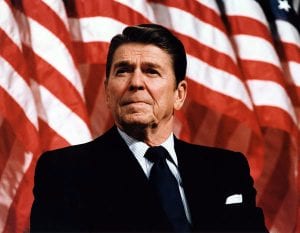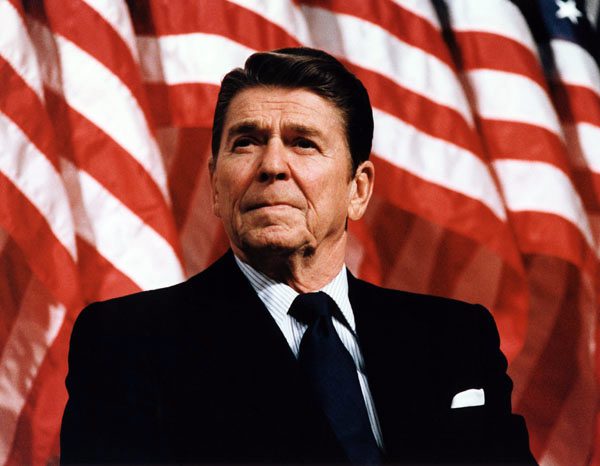
President Reagan speaking at a rally for Senator Durenberger in 1982. Photo by Michael Evans. Courtesy of Ronald Reagan Library, National Archives and Records Administration, CC BY-SA 2.0
As some Americans mourn the death of Ronald Reagan, let us recall that the two-term president was no friend to America’s cities or its poor. Reagan came to office in 1981 with a mandate to reduce federal spending. In reality, he increased it through the escalating military budget, all the while slashing funds for domestic programs that assisted working class Americans, particularly the poor.
Reagan’s fans give him credit for restoring the nation’s prosperity. But whatever economic growth occurred during the Reagan years only benefited those already well off. The income gap between the rich and everyone else in America widened. Wages for the average worker declined and the nation’s homeownership rate fell. During Reagan’s two terms in the White House, which were boon times for the rich, the poverty rate in cities grew.
His indifference to urban problems was legendary. Reagan owed little to urban voters, big-city mayors, black or Hispanic leaders, or labor unions—the major advocates for metropolitan concerns. Early in his presidency, at a White House reception, Reagan greeted the only black member of his Cabinet, Housing and Urban Development (HUD) Secretary Samuel Pierce, saying: “How are you, Mr. Mayor? I’m glad to meet you. How are things in your city?”
Reagan not only failed to recognize his own HUD Secretary, he failed to deal with the growing corruption scandal at the agency that resulted in the indictment and conviction of top Reagan administration officials for illegally targeting housing subsidies to politically connected developers. Fortunately for Reagan, the “HUD Scandal” wasn’t uncovered until he’d left office.
Reagan also presided over the dramatic deregulation of the nation’s savings and loan industry allowing S&Ls to end their reliance on home mortgages and engage in an orgy of commercial real estate speculation. The result was widespread corruption, mismanagement and the collapse of hundreds of thrift institutions that ultimately led to a taxpayer bailout that cost hundreds of billions of dollars.
The 1980s saw pervasive racial discrimination by banks, real estate agents and landlords, unmonitored by the Reagan administration. Community groups uncovered blatant redlining by banks using federal Home Mortgage Disclosure Act information. But Reagan’s HUD and justice departments failed to prosecute or sanction banks that violated the Community Reinvestment Act, which prohibits racial discrimination in lending. During that time, of the 40,000 applications from banks requesting permission to expand their operations, Reagan’s bank regulators denied only eight of them on grounds of violating CRA regulations.
By the end of Reagan’s term in office federal assistance to local governments was cut 60 percent. Reagan eliminated general revenue sharing to cities, slashed funding for public service jobs and job training, almost dismantled federally funded legal services for the poor, cut the anti-poverty Community Development Block Grant program and reduced funds for public transit. The only “urban” program that survived the cuts was federal aid for highways—which primarily benefited suburbs, not cities.
These cutbacks had a disastrous effect on cities with high levels of poverty and limited property tax bases, many of which depended on federal aid. In 1980 federal dollars accounted for 22 percent of big city budgets. By the end of Reagan’s second term, federal aid was only 6 percent.
The consequences were devastating to urban schools and libraries, municipal hospitals and clinics, and sanitation, police and fire departments – many of which had to shut their doors.
Reagan is lauded as “the great communicator,” but he sometimes used his rhetorical skills to stigmatize the poor. During his stump speeches while dutifully promising to roll back welfare, Reagan often told the story of a so-called “welfare queen” in Chicago who drove a Cadillac and had ripped off $150,000 from the government using 80 aliases, 30 addresses, a dozen social security cards and four fictional dead husbands. Journalists searched for this “welfare cheat” in the hopes of interviewing her and discovered that she didn’t exist.
The imagery of “welfare cheats” that persists to this day helped lay the groundwork for the 1996 welfare reform law, pushed by Republicans and signed by President Clinton.
The most dramatic cut in domestic spending during the Reagan years was for low-income housing subsidies. Reagan appointed a housing task force dominated by politically connected developers, landlords and bankers. In 1982 the task force released a report that called for “free and deregulated” markets as an alternative to government assistance – advice Reagan followed. In his first year in office Reagan halved the budget for public housing and Section 8 to about $17.5 billion. And for the next few years he sought to eliminate federal housing assistance to the poor altogether.
In the 1980s the proportion of the eligible poor who received federal housing subsidies declined. In 1970 there were 300,000 more low-cost rental units (6.5 million) than low-income renter households (6.2 million). By 1985 the number of low-cost units had fallen to 5.6 million, and the number of low-income renter households had grown to 8.9 million, a disparity of 3.3 million units.
Another of Reagan’s enduring legacies is the steep increase in the number of homeless people, which by the late 1980s had swollen to 600,000 on any given night – and 1.2 million over the course of a year. Many were Vietnam veterans, children and laid-off workers.
In early 1984 on Good Morning America, Reagan defended himself against charges of callousness toward the poor in a classic blaming-the-victim statement saying that “people who are sleeping on the grates…the homeless…are homeless, you might say, by choice.”
Tenant groups, community development corporations and community organizations fought to limit the damage done by Reagan’s cutbacks. Some important victories were won when Clinton entered office—the expansion of the Earned Income Tax Credit and stronger enforcement of the CRA. Funding for low-income housing, legal services, job training and other programs has never been restored to pre-Reagan levels, and the widening disparities between the rich and the rest persist.
President George W. Bush, who often claims Reagan’s mantle, recently proposed cutting one-third of the Section 8 housing vouchers—a lifeline against homelessness for two million poor families.
We’ve already named a major airport, schools and streets after Ronald Reagan, and since his death some people have suggested other ways to celebrate his memory. Perhaps a more fitting tribute to his legacy would be for each American city to name a park bench— where at least one homeless person sleeps every night—in honor of our 40th president.




Well-said. I was homeless for a time and know the treatment of the homeless has to change. I know that our shelter and post-housing needs to change. I see a few towns now providing “tiny houses” for their homeless veterans. It would be nice to see this expand to the general homeless population–if not “Tiny homes” then some sort of studio apartments. Homelessness was not a problem until Regan chose to implicitly criminalize it.
What a myopic argument to ignore the role of the Democratic controlled house and senate during the Reagan years! Civics lesson time! Who makes the laws? Ah, that’s right – it’s Congress. The better summary for this article would be for the Reagan era D- Congress to raise their hands in the air and in unison shout, “yes, we really sucked – but we want to hang it all on Reagan!” That would actually be accurate.
What a hollow argument your reply is to not providing any evidence. You pointed the finger at the “then” Democratic lead Congress, but you failed to support your opinion with any evidence. Zilch. Real Civics Lesson 101 time. What bills did a democratic congress pass on to a then far right republican president to have signed into law? That’s the civics lesson. What should congress have done? What laws and programs did Reagan sign and support that protected and benefited the large cities and the poor? Like so many republicans, you claim the Democrats suck but without any real evidence. This article clearly spelled out reason after reason why Reagan was no friend to the urban dwellers, the poor, and the homeless. Reagan drastically slashed federal funding that clearly benefitted the large metropolitan areas of our country, all the while, cutting taxes on the wealthy, and widening the income gap. He deregulated the savings and loan industry. Reagan demonized and stigmatized the poor by claiming it was their own fault, or deferred to them as welfare cheats, again, without evidence. He slashed low income housing. This article provided clear evidence why Reagan greatly increased our homeless problem which still exists 40 plus years later. Reading lesson time! Reread the article and find better arguments than just your empty opinion.
Mass shootings also increased under his watch when he defunded mental state hospitals first in California when he was governor and then when he became president. – Homelessness and hit an all time hight its time to reverse his policies and allow government to get in evolved n governing mental health so we can survive Reagans brutality as he watched us tucked away in his ivory untouchable tower of the central coast of California. In the wealthiest most beautiful area of our nation , he basically untied the binds of humanity and ignored the cries from the poor. The worst president ever.